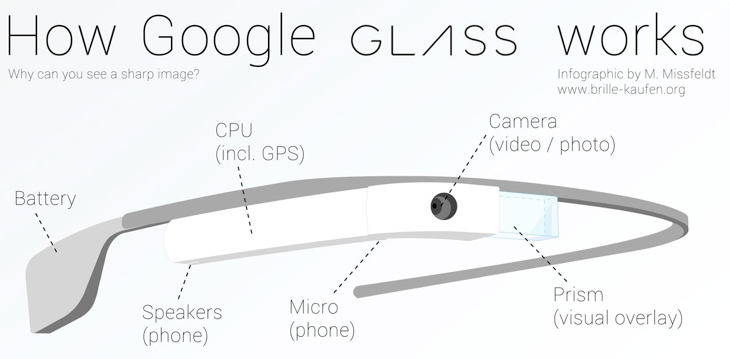Introduction Google Glass apps
17 October 2013 - John Kivit
Google Glass is the next step towards the integration of technology into our daily lives. Since i first saw Google Glass in real life at the beginning of this year i can’t let go of the exciting idea to develop applications for it. But where do you start and how does it work? This article provides answers to some important questions about Google Glass and apps.
What is Google Glass?
Google Glass is a wearable computer with an optical head-mounted display (OHMD). It weighs no more than a pair of sunglasses, but has all the latest technology on board. It is controlled by voice or the touchpad on the right side of the Glass. Images are projected into the eye with a small mini projector and a prism. The transparent image being projected is at the top right corner of your vision. Google Glass can be best described as a ‘picture-in picture’ for your real world. Glass connects to the Internet by wifi or bluetooth on an (Android) phone. The video below show the basics.
What technology is inside Google Glass?
- Display: resolution of 640 x 360. According to Google the quality is comparable to ‘looking at a 25 inch HD screen from eight feet away’.
- Camera: for pictures (5MP) and video (720p)
- Audio: bone conduction transmits audio directly to the innermost part of the ear by means of a transducer, placed on the bone of the skull.
- Voice control / touchpad: to control the device
- Battery: works for a day at normal usage and is charged by micro USB.
- CPU, microphone, wifi & bluetooth
- Storage: 12 GB free
Where can i buy Google Glass?
Google Glass is not for sale for consumers yet. A small group of Google selected developers and testers had the opportunity to buy Glass for $1.500. They are now part of the Glass Explorer program. In the Netherlands only a handful of people own a Google Glass. It is expected that Glass will have its official introduction in 2014 for a retail price between $300 and $500.
How does it look like?
The images of the Glass are projected over your real life vision as a transparent, virtual layer. In the video below you can see it through the eyes of a user.
Which apps are available?
The most important app is the ‘OK Glass Launcher’ app. With it you can give voice command instructions for searching, taking pictures & video, navigating, sending messages, (video) chatting, making calls and sharing content. The time and weather are also part of the core functionality. More and more external parties are developing Glassware (apps for Google Glass). Companies like CNN, Elle, Evernote, Facebook, New York Times, Twitter and Tumblr have introduced their own glassware apps recently. A more complete list can by found at this Google Glass Application List.
How are apps for Google Glass made?
For now, Google Glass is mainly a content consumption and sharing device. Google wants developers to push HTML info (text, photo, video) to the user and receive commands, photos and videos from the user. Every item that is sent to the user is shown as a ‘card’ on its timeline. Actions can be added to those items (e.g. sharing). Developers have access to the contacts list and location of users if they allow it.
Google Glass is running on Android (4.04). Google is working on a Glass Development Kit (GDK) with more options, but for now it is possible to use the Android SDK to write applications. The Google Mirror API takes care of sending and receiving information to and from glassware. Backend technology for glassware can be written in languages like Java, .Net or PHP. More technical information can be found on the Google Glass developer portal.
What are the guidelines?
Google Glass is a complete new experience that cannot be compared to the user experience on a PC or Smartphone. Glass is designed to deliver quick and pertinent information to users while not interfering with their lives. It is very close to users' senses and offers a brand new interface and experience.
These are the guidelines that Google provides:
- Design for Glass: Glass is fundamentally different from existing mobile platforms in both design and use. Build your Glassware with this in mind, and design it specifically for Glass.
- Don't get in the way: Glass users expect the technology to be there when they want it and out of the way when they don't. Your Glassware should never take precedence over users' lives.
- Keep it timely: Glass is a platform that is most effective when in-the-moment and up-to-date. Always deliver fresh and relevant content to users.
- Avoid the unexpected: Surprising the user with unexpected functionality is bad on any platform, but especially on Glass, because it is so close to a user's daily experience.
Lets get in touch!
Are you thinking about entering the market with Google Glass apps in the future? Shareforce would love to brainstorm with you about the possibilities. Wearables like Glass will change the market fundamentally and its best to start early in preparing for that!
 Shareforce vraagt om je toestemming om meldingen te kunnen sturen.
Shareforce vraagt om je toestemming om meldingen te kunnen sturen. 